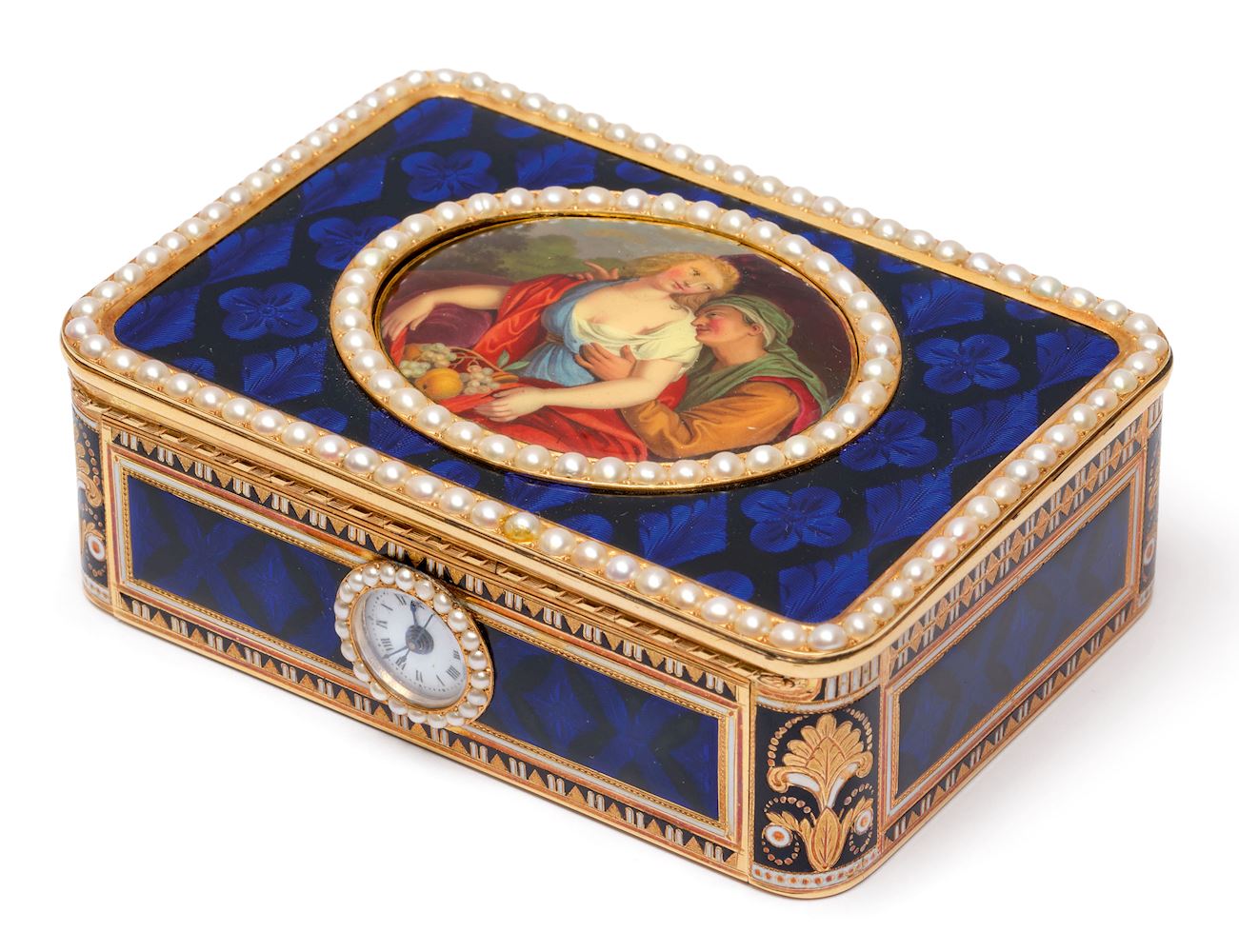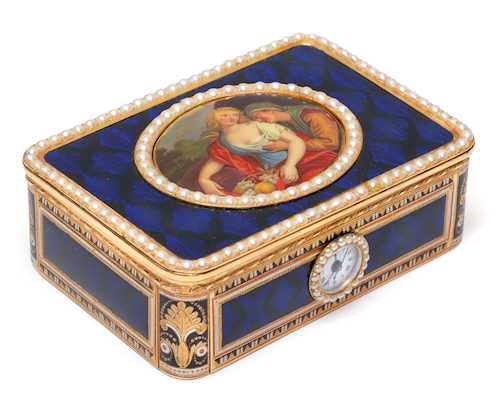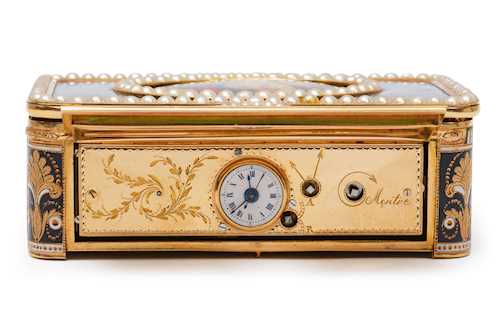
拍品 1191 - A208 家具、瓷器&银器 - Donnerstag, 21. März 2024, 01.30 PM
GOLD ENAMEL BOX WITH SINGING BIRD AUTOMATON, CLOCK AND SMALL CYLINDER MUSIC BOX MECHANISM
Geneva, ca. 1810-25, Rochat Brothers (Rochat Frères, active in Geneva 1810-1825), Maker's mark IGRC for Rémond Lamy Mercier & Co.
Gold, engine-turned and overlaid with translucent cobalt blue enamel. Rectangular shape, the corners rounded and decorated with floral motifs in engraved gold and white enamel. Framed by decorative leaf friezes in white enamel and gold. Hinged lid, framed in a pearl frieze. Underneath, a white/blue enamel cover engraved with flowers with the winding holes for the singing bird automaton and a small cylinder music box mechanism. The center of the lid has an oval opening framed by a pearl frieze and covered by an oval lid depicting a couple in love. This lid opens via a sliding lever and reveals the whistling and moving bird. The hinged front contains a small clock with a white enamel dial and bezel lined with pearls, the movement with 4/4 hour repeater and second hand. Another hinged cover on the side for storing the winding key.
8.4 × 6.2 × 2.8 cm.
Mounting of the connection between the lifting lever of the bird and the slider is broken. Singing bird movement jammed. Clock movement requires revision. Enameling with minor losses.
Provenance:
- Galerie Koller Zurich, November 1964, lot 1328.
- Private collection, Switzerland (acquired at the above auction).
Bird automatons from Geneva were among the most exquisite objects that could be acquired in the 19th century. Such jewel-like creations are the result of a combination of the finest goldsmith's work and the complex mechanism of a watchmaker. They feature a brightly feathered bird emerging from a finely engraved gold nest and chirping energetically as it moves its beak and wings. They were highly coveted beyond the borders of Switzerland and Europe to the Far East and North America.
Some of the finest examples can be seen in the most important museums of this genre, such as the Musée de L'Horlogerie et de l'Emaillerie, the Patek Philippe Museum in Geneva and in the permanent exhibition of the Edouard and Maurice Sandoz collection at the Musée de l'Horlogerie du Locle, Switzerland.
The movement bears the FR mark, the Maker's mark of the famous Rochat brothers, established masters of clock movements and singing bird automatons. Before setting up their own business in Geneva between 1800 and 1835, they were initially trained by their father Pierre in Le Brassus in the canton of Vaud in Switzerland and were later employed as watchmakers by Jaquet-Droz and Leschot. The talented brothers François Elisée, Frédéric and Samuel-Henri Rochat were soon among the elite of the best makers of singing bird automatons and automatic watches.
The elaborate and extremely finely crafted gold case with translucent enamel and applied pearls (mainly intended for the Chinese market) was made by the famous goldsmith Jean-Georges Rémond (1752-1830), who originally came from Hanau and had made an excellent name for himself for his exquisite gold work for watches after founding his first company "Georges Rémond & Cie" in Geneva in 1783. By 1806, he had already founded several other companies and employed 100 people. His creations were exhibited in Paris and London and sold to customers in Germany, Russia, Turkey and China.
The development of mechanical singing bird automatons can be traced back to an amusing fashion trend in the 17th century that was followed by society ladies. They perfected the breeding and training of canaries and practiced buying and selling the birds almost as a sport, although the trade was frowned upon, if not strictly forbidden, for upper-class women at the time. The birds were originally imported from the Canary Islands, but were later bred in Europe due to the high demand.
Raising the birds and teaching them to sing was a masterful discipline that required a lot of time and dedication. Canaries sing naturally, but their singing can be greatly improved by repeatedly exposing them to sweet melodies. They need to be isolated from other canaries from a young age, and music needs to be played to them regularly, originally using a type of flute called a flageolet. The canaries do not learn the songs note for note, but imitate the key and the sequence of notes very precisely - if the key is too high for them, they apparently injure themselves trying to imitate it.
Jean-Claude Hervieux de Chanteloup (1683-1747), a naturalist and French ornithologist, describes the training of canaries in detail in his authoritative book "Nouveau Traité Des Sérins De Canarie, contenant La manière de les connoître & de les élever..." Paris, Fournier 1709 (Bibliothèque nationale de France, Catalogue général). In chapters 28 and 29, he explains how canaries can be taught to sing with the help of a bird organ, the so-called serinette (after "serin", the old French word for canary). These instruments, which resemble small barrel organs, were invented specifically so that canary owners could teach their birds to sing without having to play the flute to them. This was certainly a godsend for those who did not have the services of a professional canary trainer like de Chanteloup, who recommended giving five or six lessons a day.
The bird organ (serinette) was soon combined with the bird automatons, which were often presented in gilt cages. At the end of the 18th century, the serinette was replaced by a far more sophisticated mechanism that used a sliding piston to produce a more lifelike bird melody, the development of which is attributed to Jaquet-Droz and Son. This enabled the production of smaller and more precise movements such as the one offered here, which developed in parallel with precision watchmaking, which was to become an important element of the Swiss economy and Switzerland's reputation in the centuries to come (Cf. Sharon and Christian Bailly, Flights of Fancy. Mechanical Songbirds, 2001).
Provenance:
- Galerie Koller Zurich, November 1964, lot 1328.
- Private collection, Switzerland (acquired at the above auction).
Bird automatons from Geneva were among the most exquisite objects that could be acquired in the 19th century. Such jewel-like creations are the result of a combination of the finest goldsmith's work and the complex mechanism of a watchmaker. They feature a brightly feathered bird emerging from a finely engraved gold nest and chirping energetically as it moves its beak and wings. They were highly coveted beyond the borders of Switzerland and Europe to the Far East and North America.
Some of the finest examples can be seen in the most important museums of this genre, such as the Musée de L'Horlogerie et de l'Emaillerie, the Patek Philippe Museum in Geneva and in the permanent exhibition of the Edouard and Maurice Sandoz collection at the Musée de l'Horlogerie du Locle, Switzerland.
The movement bears the FR mark, the Maker's mark of the famous Rochat brothers, established masters of clock movements and singing bird automatons. Before setting up their own business in Geneva between 1800 and 1835, they were initially trained by their father Pierre in Le Brassus in the canton of Vaud in Switzerland and were later employed as watchmakers by Jaquet-Droz and Leschot. The talented brothers François Elisée, Frédéric and Samuel-Henri Rochat were soon among the elite of the best makers of singing bird automatons and automatic watches.
The elaborate and extremely finely crafted gold case with translucent enamel and applied pearls (mainly intended for the Chinese market) was made by the famous goldsmith Jean-Georges Rémond (1752-1830), who originally came from Hanau and had made an excellent name for himself for his exquisite gold work for watches after founding his first company "Georges Rémond & Cie" in Geneva in 1783. By 1806, he had already founded several other companies and employed 100 people. His creations were exhibited in Paris and London and sold to customers in Germany, Russia, Turkey and China.
The development of mechanical singing bird automatons can be traced back to an amusing fashion trend in the 17th century that was followed by society ladies. They perfected the breeding and training of canaries and practiced buying and selling the birds almost as a sport, although the trade was frowned upon, if not strictly forbidden, for upper-class women at the time. The birds were originally imported from the Canary Islands, but were later bred in Europe due to the high demand.
Raising the birds and teaching them to sing was a masterful discipline that required a lot of time and dedication. Canaries sing naturally, but their singing can be greatly improved by repeatedly exposing them to sweet melodies. They need to be isolated from other canaries from a young age, and music needs to be played to them regularly, originally using a type of flute called a flageolet. The canaries do not learn the songs note for note, but imitate the key and the sequence of notes very precisely - if the key is too high for them, they apparently injure themselves trying to imitate it.
Jean-Claude Hervieux de Chanteloup (1683-1747), a naturalist and French ornithologist, describes the training of canaries in detail in his authoritative book "Nouveau Traité Des Sérins De Canarie, contenant La manière de les connoître & de les élever..." Paris, Fournier 1709 (Bibliothèque nationale de France, Catalogue général). In chapters 28 and 29, he explains how canaries can be taught to sing with the help of a bird organ, the so-called serinette (after "serin", the old French word for canary). These instruments, which resemble small barrel organs, were invented specifically so that canary owners could teach their birds to sing without having to play the flute to them. This was certainly a godsend for those who did not have the services of a professional canary trainer like de Chanteloup, who recommended giving five or six lessons a day.
The bird organ (serinette) was soon combined with the bird automatons, which were often presented in gilt cages. At the end of the 18th century, the serinette was replaced by a far more sophisticated mechanism that used a sliding piston to produce a more lifelike bird melody, the development of which is attributed to Jaquet-Droz and Son. This enabled the production of smaller and more precise movements such as the one offered here, which developed in parallel with precision watchmaking, which was to become an important element of the Swiss economy and Switzerland's reputation in the centuries to come (Cf. Sharon and Christian Bailly, Flights of Fancy. Mechanical Songbirds, 2001).
CHF 60 000 / 100 000 | (€ 61 860 / 103 090)
以瑞士法郎銷售 CHF 206 250 (包含買家佣金)
所有信息随时可能更改。






